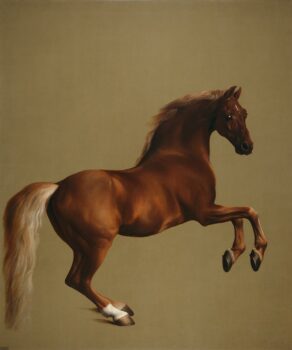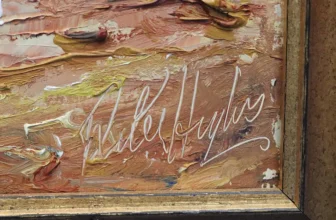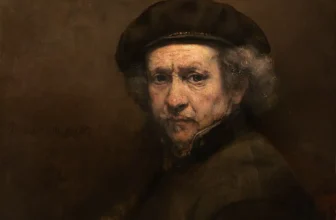An In-Depth Analysis of Whistlejacket Painting
In the grand halls of London’s National Gallery, a monumental horse rears to life, almost leaping from the canvas in a spirited assertion of natural grace and raw power. The horse is Whistlejacket, and the man who captured its electric presence is George Stubbs, one of Britain’s most revered equine painters. Painted around 1762, Whistlejacket is not merely a portrait of a horse; it is an iconic fusion of art, nature, anatomy, and symbolism, a visual masterpiece that continues to command attention, inspire awe, and provoke analysis over two centuries later.
This story seeks to unravel the deeper meanings, context, symbolism, and interpretation of Whistlejacket by George Stubbs. It explores what the painting is about, the style it represents, the historical and artistic backdrop against which it was painted, and its legacy in today’s art world.
Who Painted Whistlejacket?
George Stubbs (1724–1806) was an English painter, best known for his masterful portrayals of horses. A self-taught artist with a deep interest in anatomy, Stubbs brought a scientific precision to his artwork that was unmatched in his time. While many of his contemporaries focused on grand portraits of aristocrats or historical scenes, Stubbs carved a niche for himself in equine portraiture, a subject close to the heart of 18th-century British nobility.
Stubbs’ dedication to understanding his subject was unparalleled. In 1766, he published The Anatomy of the Horse, a meticulous study based on his own dissections. This work remains a landmark in both veterinary science and artistic realism. It is precisely this scientific rigor, combined with artistic elegance, that breathes life into Whistlejacket.
What Is the Whistlejacket Painting All About?
At first glance, Whistlejacket seems like a straightforward horse portrait. The subject, an Arabian thoroughbred stallion, rears majestically against a plain, light ochre background. There is no landscape, no rider, no elaborate setting. The horse is entirely alone, suspended mid-motion in an almost surreal moment of life. But the simplicity is deceptive.
The painting is a celebration of natural beauty and animal spirit, unencumbered by human trappings. Commissioned by the 2nd Marquess of Rockingham, a prominent political figure and Whig aristocrat, the painting immortalizes his prized stallion, Whistlejacket, who was famous for his racing prowess and fiery temperament.
According to legend, when the real Whistlejacket saw the painting, he charged at it, believing it to be a rival. Whether apocryphal or not, the story speaks to the painting’s startling realism and the spirit Stubbs infused into his subject.
What Type of Art Is Whistlejacket?
Whistlejacket is a work of equestrian portraiture, a subgenre of portraiture focused on horses, often in the service of glorifying the wealth and status of their owners. However, Stubbs elevates this genre to something far more profound.
Technically, the painting can be categorized as:
Naturalism: Its precise anatomical detail reflects Stubbs’ scientific approach to painting.
Romanticism (Proto-Romanticism): Though created before the full bloom of Romantic art, Whistlejacket embodies themes of raw emotion, untamed nature, and individualism, hallmarks of Romanticism.
Neoclassicism: There is an echo of classical sculpture in the horse’s pose and proportions, suggesting a timeless, idealized form.
Despite fitting into these broader categories, Whistlejacket defies easy classification. Its blank background and enormous scale (almost life-sized) strip away context and focus all attention on the animal itself, making it radically modern for its time.
Symbolism and Interpretation of Whistlejacket
While ostensibly a realistic portrait of a horse, Whistlejacket is laden with symbolic meanings and interpretations that reach beyond the canvas.
1. Power and Freedom
The rearing pose, usually associated with a horse under command, here suggests wildness and autonomy. Whistlejacket is unbridled, unsaddled, and alone, symbolizing freedom and untamed vitality. In a time when horses were emblems of control and mastery, Stubbs flips the narrative, here, the horse is the hero.
2. Individual Identity
The painting focuses solely on Whistlejacket’s individuality. This was unusual for equine portraiture of the time, which often included riders or landscapes. Stubbs grants the horse a personality, portraying it not merely as an object but as a subject with its own presence. It is a radical move that anticipates the modern concept of animal sentience.
3. Status and Nobility
Horses were symbols of wealth and prestige in 18th-century Britain, especially Arabian stallions like Whistlejacket. By commissioning this painting, the Marquess of Rockingham wasn’t just immortalizing a pet, he was asserting his aristocratic status, aligning himself with classical ideals of beauty, and participating in the Enlightenment’s reverence for nature.
4. Human-Animal Relationship
There is a subtle commentary on the relationship between humans and animals. The horse, usually domesticated and controlled, is shown here in full autonomy. It hints at a reverence for animal intelligence and dignity, a perspective that was uncommon in Stubbs’ era.
5. A Monument to Naturalism
Stubbs’ choice to eliminate all background context emphasizes the horse’s anatomy, musculature, and movement. This turns Whistlejacket into a living anatomy lesson, a visual monument to natural form.
What Is Happening in the Whistlejacket Painting?
On the canvas, Whistlejacket is rearing up, possibly in reaction, possibly in play, but definitely in motion. His mane flows, his tail curls, his nostrils flare, and his eyes flash with energy. The light subtly defines his muscular structure, while shadows contour his chest and legs.
Yet, what is equally striking is what’s not happening:
There is no background. The horse appears suspended in an undefined space.
There is no rider or human figure.
There are no props, no saddle, no landscape, nothing to distract from the subject.
This near-abstract isolation makes the painting all the more powerful. The horse is neither decorative nor functional, it simply is, as if asserting its right to exist as art in its own right.
Some art historians believe that the painting may have been part of a larger commission that was never completed. The blank background might have been a placeholder for a more elaborate setting. However, the decision to leave it bare (whether intentional or circumstantial) results in a startling minimalism that feels avant-garde, even today.
The Revolutionary Nature of Whistlejacket
What makes Whistlejacket revolutionary is how far it deviates from convention:
Most animal portraits of the time were secondary to human figures; Stubbs places the animal at the center.
The painting is life-sized, over 10 feet tall and nearly 9 feet wide, normally reserved for royal or mythological subjects.
The absence of landscape or narrative setting is radically modern; it foreshadows the minimalist and expressionist movements of the 20th century.
In many ways, Whistlejacket is not just a portrait, it is a monument to motion, muscle, and moment, a proto-modern study of form and force that transcends its time.
Where Is the Whistlejacket Painting Located Today?
Today, Whistlejacket resides in the National Gallery in London, where it is prominently displayed and remains one of the museum’s most admired pieces.
Its presence in such a revered institution is a testament to its lasting importance, not just as an equine portrait, but as a pioneering work of British art. It continues to attract artists, students, historians, and animal lovers alike, all drawn to the mystery, power, and beauty of Stubbs’ creation.
Legacy and Influence of Whistlejacket
Whistlejacket has influenced generations of artists and thinkers. Its bold focus on an animal subject challenged the anthropocentric norms of 18th-century art and anticipated modern explorations of animal consciousness and environmental aesthetics.
Some of its broader influences include:
Animal Rights Discourse: Seen in a modern light, the painting contributes to a visual tradition that recognizes animal subjectivity and dignity.
Minimalism and Modernism: The empty background and emphasis on form and line can be read as early expressions of minimalist ideals.
Equestrian Art: Stubbs set a new standard for equestrian portraiture, one rooted in anatomy, realism, and empathy.
In contemporary discussions of art, Whistlejacket is often cited as an example of how genre paintings can transcend genre, how depictions of animals can reveal as much about humans, and how simplicity can evoke profundity.
A Timeless Masterpiece of Animal Art
George Stubbs’ Whistlejacket remains one of the most enigmatic and arresting paintings in British art history. It stands as a tribute not only to a specific horse but to the larger idea of animal vitality, natural beauty, and artistic purity.
Stubbs’ revolutionary approach, removing the background, focusing on anatomy, honoring the subject’s individuality, still resonates today. Whistlejacket is a painting that speaks to art lovers and animal lovers alike. It is not merely a horse on a canvas; it is the essence of movement, pride, and life made eternal.
In a world increasingly attuned to the natural world and its preservation, Whistlejacket continues to gallop through our collective imagination, majestic, unbound, and unforgettable.




